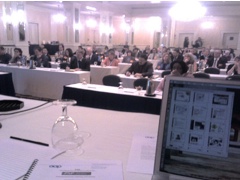 I hate to admit this, but I’m glad that they weren’t paying me for yesterday’s panel event at the Association of American Publishers conference yesterday. I don’t think that I solved any problems for them — at least for the time being. Most of the panelists had fairly concrete suggestions on how they should adapt their services to match the changing information environment. I simply introduced them to the millennials — their customers five years from now. Several people said that they enjoyed the presentation and that it made them think differently about their own children, and I suspect that there may be moments in the future that they will think back on the presentation. But I simply do not like not helping.
I hate to admit this, but I’m glad that they weren’t paying me for yesterday’s panel event at the Association of American Publishers conference yesterday. I don’t think that I solved any problems for them — at least for the time being. Most of the panelists had fairly concrete suggestions on how they should adapt their services to match the changing information environment. I simply introduced them to the millennials — their customers five years from now. Several people said that they enjoyed the presentation and that it made them think differently about their own children, and I suspect that there may be moments in the future that they will think back on the presentation. But I simply do not like not helping.
Otherwise, it was a fantastic day of my learning from some really smart people — the other panelists. The the larger session was called Publishing 2.0: Flourishing in the Era of Digital Natives. Among the other panelists are Stephen Rhind-Tutt, President of Alexander Street Press, Timothy Burke, Associate Professor of History at Swarthmore College, Greg Suprock, New Technology Director of Nature Publishing Group, and CJ Rayhill, Chief Information Officer at O’Reilly Media. The moderator was Patricia Seybold, an apparently very well known consultant. She’s written a book on innovation.
Patti provided some context and listed, as the main themes: intellectual properties, user produced content, and online communities. She is making several mentions of re-mixable content, information that is more of a raw material that consumers can remix.
Stephen Rhind-Tutt said first thing that, “One of the conditions brought about by Web 2.0 is that is no long real expertise.” It’s all growing too fast. Web 2.0 is not about the Web 2.0 companies. He says that if the job of publishers is to make sure that the consumer has access to the right information at the right time, then publishing must tap into the new web.
Stephen ask how many people know about blogging, RSS, API, del.icio.us, etc., and most hands go up. This is going to be a tough crowd. Rhind-Tutt’s company has a web site about the post-60s feminist movement. When they found that most of the people who were visiting the site actually had personal experiences, photographs, and other resources related to the topic, they opened it up, and turned the site into an online community that invited participation among the visitors.
In talking about taxonomy vs. Folksonomy, he suggests that we actually need both. There are advantages to user applied tags, but also vast advantages to librarian applied tags (Go Librarians, Go!). He says that we need both, that they support each other. They are not competitive. Stephen reminds us that we are developing some very sophisticated search technologies and features, even though only 5% to 10% of users take advantage of them. He says that this is ok, that our job is not just to make content available but to promote scholarship. Google, on the other hand, doesn’t (Stephen Rhind-Tutt’s words).
Wow, he’s demonstrating a product of his company where college teachers can scroll through videos, and then select specific clips within the videos. The service then provides a hyperlink directly to that clip. This is not new, but exactly the kind of value adding re-mixable resource that teachers (and students) need.
After giving my presentation, I reflected that perhaps our children, who are so intensely engaged in their information experiences, are going to be a very hard customership for publishers to connect with. That could be correct, or it may be that they are even more reachable for the same reasons.
One person reminded me that I said, early in my presentation, that children were willing to pay for their information. He asked me to explain, since my audience was out to sell information. I corrected my statement by saying the they are willing to pay for an information experience. They by music and movies, and books, but its the experience of the video game and of mixing content that value. I suggested that publisher need to find a way to turn their content into and experiencable product. I don’t think they like it when you make up a word.
Timothy Burke then talked about academic blogging, and he was very very good. He said, first off, that “monograph is over and good riddance.” There’s a message there for education as well as publishing. He says that academics do not consider themselves part of the Web 2.0 generation. Yet, the community is starting to rethink blogging as a venue for academic publishing.
Timothy’s presentation was extraordinarily balanced. I tend to evangelize, perhas too much. He says that there are many ways that blogging can be used in the academic world, but that the very best that can be said is that it will make academics better writers — able to write to broader audiences.
Academics do three kinds of blogs
- academic blogs (intended to serve traditional functions of publishing)
- Academics who blog (basically diaries or live journals)
- Hybrids (includes elements of serious reports and diaries)
In a recent article in EdTech, I labeld three types of K12 teacher bloggers
- Teachers who blog
- Teacher bloggers
- Teachers who promote student blogging for instructional purposes
Burke said that although he is not sure that blogging is all that important, all that disruptive, he admits that his blog has been incredibly useful to him professionally. He puts his course syllabi on his blog and has changed his material and even required reading based on the comments that he has received. He’s suggesting that one value of blogging to publishers is to take advantage of the blogged reviews/conversations. This reminds me of the Laptop Institute, which grew dramatically in 2006, largely as a result of the blogging that happened during the 2005 conference.
He’s also suggesting that blogging can be a source of possible authors. Publishers should be paying attention to blogs, looking for writers who are good communicators and knowledgeable. Finally, he suggests blogs and wikis can be a very effective way to extend and update books. It has to be in a model different from the textbook, perhaps a controlled wiki.
Blogs can be the incubator for a book. The Long Tail is certainly an example of this. They (blogs) can also be converted directly into a book. But he suspects that only a few academic blogs are suitable for this, because of the writing styles. He also suggests that blogs might be something that could replace conference proceedings. This is an interesting idea to me, to put session descriptions on a conference blog, and then invite reading and commenting on the sessions.
At lunch, a number of people have talked with me, but mostly from the context of their own children. The connection between our children’s information experiences and publishing, especially in terms of business models, is not obvious, either for them or for me. Any ideas?
The next panelists are undergraduate and graduate students who are involved in digital content projects. Two are involved in open access, one of whom is a bit of a radical, the other appreciates librarians and publishers. The third, a post doctorate students, is working on a project to hyperlink middle english literature. The first student, the radical, says that there is a perception that publishers are getting in the way. He challenges the audience to change that perception. Kinda applicable to librarians. Change people’s perception of who you are.
Another student states that researchers are insulted unless the work is not available digitally, and as scholars, they are insulted when their work is not printed on paper. How true this is. Authority, to some extent, is social.
Interestingly, two of the young men stated at different times that the issue of the authority of content is not new and it is not a technical issue. It is an issue of literacy. One of them mentioned a report recently published by the Education Testing Service about technical fluency. It cited that 49% of youngsters did not know how to determine the authenticity and timeliness of information. He then said that this is not an issue of technical fluency. It is information literacy. Bingo!
Greg Suprock, emerging technology director of Nature Publishing Group, says that there are four natural forces at work in the evolving information environment.
- The Power of Users (Digg)
- The strength of collaboration (del.icio.us)
- The energy of groups (talks about Nature Network from his company that allows users to form groups that collaborate together)
- The value of quality (talks about Nature Protocols — journal web site that also accepts entries from visitors with moderation in place)
Unfortunately, I had to leave right after the final panelist, CJ Rayhill, Chief Information Officer at O’Reilly Media, got started. I did note that she claimed to have lost count after 26, the times that the term Web 2.0 had been used. I think I only used it once.
Technorati Tags : warlick technology publishing information literacy web2.0 web20 blogging
 I’ve said before, that when our classrooms fill with students who, from the perspective of their information landscape, are more literate than their teachers, then our classrooms become flat. We can no longer rely on the gravity of monolog to drive instruction. Monolog is meaningless — on so many levels. School 2.0 must tap into what Greg Suprock called the natural forces of the evolving information environment: The power of users, the strength of collaboration, the energy of groups, and the value of quality — and all of this happens in the dynamic and multidimensional conversations that are increasingly possible in today’s learning environments.
I’ve said before, that when our classrooms fill with students who, from the perspective of their information landscape, are more literate than their teachers, then our classrooms become flat. We can no longer rely on the gravity of monolog to drive instruction. Monolog is meaningless — on so many levels. School 2.0 must tap into what Greg Suprock called the natural forces of the evolving information environment: The power of users, the strength of collaboration, the energy of groups, and the value of quality — and all of this happens in the dynamic and multidimensional conversations that are increasingly possible in today’s learning environments.
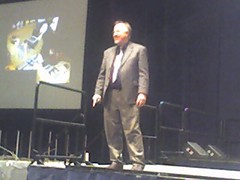
 I hate to admit this, but I’m glad that they weren’t paying me for yesterday’s panel event at the Association of American Publishers conference yesterday. I don’t think that I solved any problems for them — at least for the time being. Most of the panelists had fairly concrete suggestions on how they should adapt their services to match the changing information environment. I simply introduced them to the millennials — their customers five years from now. Several people said that they enjoyed the presentation and that it made them think differently about their own children, and I suspect that there may be moments in the future that they will think back on the presentation. But I simply do not like
I hate to admit this, but I’m glad that they weren’t paying me for yesterday’s panel event at the Association of American Publishers conference yesterday. I don’t think that I solved any problems for them — at least for the time being. Most of the panelists had fairly concrete suggestions on how they should adapt their services to match the changing information environment. I simply introduced them to the millennials — their customers five years from now. Several people said that they enjoyed the presentation and that it made them think differently about their own children, and I suspect that there may be moments in the future that they will think back on the presentation. But I simply do not like 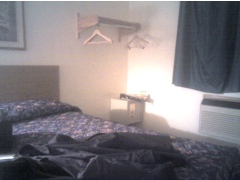 I’m in the wrong hotel room this morning. But things are so much better than the might be. As many of you probably know, only too well, much of the U.S. is very cold right now. Conditions as many airports across the country resulted in the cancelation of just about half of the USAirways flights leaving National Airport yesterday. Mine was not one of them, but it was delayed two hours, which caused me to miss my American Airlines connection in Dallas.
I’m in the wrong hotel room this morning. But things are so much better than the might be. As many of you probably know, only too well, much of the U.S. is very cold right now. Conditions as many airports across the country resulted in the cancelation of just about half of the USAirways flights leaving National Airport yesterday. Mine was not one of them, but it was delayed two hours, which caused me to miss my American Airlines connection in Dallas.
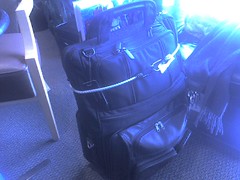
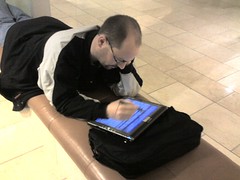 I did my Millennial Learners presentation at 8:00 AM this morning, here at the TRLD conference. It seemed to have been well received and I was pulled into several conversations by some really smart people in the hall afterward. The best thing that I can say about this conference (about which there are many great things I can say) is the conversations I’m having outside of the sessions. As I was mostly listening to people talking after my session, I tried to find in all of the statements being made, a unifying theme. It’s my nature. The one I came up with was audience. Our children are literally accustomed to having an audience. How might classroom blogging be used to leverage audience for learning.
I did my Millennial Learners presentation at 8:00 AM this morning, here at the TRLD conference. It seemed to have been well received and I was pulled into several conversations by some really smart people in the hall afterward. The best thing that I can say about this conference (about which there are many great things I can say) is the conversations I’m having outside of the sessions. As I was mostly listening to people talking after my session, I tried to find in all of the statements being made, a unifying theme. It’s my nature. The one I came up with was audience. Our children are literally accustomed to having an audience. How might classroom blogging be used to leverage audience for learning. Then I sat in the back of a hands-on workshop, a fly on the wall. It was facilitated by Austin educator,
Then I sat in the back of a hands-on workshop, a fly on the wall. It was facilitated by Austin educator,  Second, of all of the technology presentations that I’ve seen, and the conversations I have been a part of or listened to, the one thing that is certain, a do or die, is that in the future every teacher and learner will walk into their classrooms with a computer. It won’t be called 1 to 1. It will simply be called teaching and learning. And it won’t be a PDA stretched into the learning tool, and it won’t be a game system stretched into a learning tool. It will be a computer.
Second, of all of the technology presentations that I’ve seen, and the conversations I have been a part of or listened to, the one thing that is certain, a do or die, is that in the future every teacher and learner will walk into their classrooms with a computer. It won’t be called 1 to 1. It will simply be called teaching and learning. And it won’t be a PDA stretched into the learning tool, and it won’t be a game system stretched into a learning tool. It will be a computer. 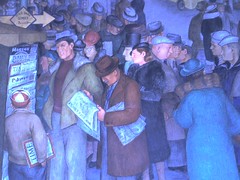 From Chinatown, we walk on down Grant to Telegraph Hill. I surely wish that I could express to you how steep this hill is, and how many steps we had to walk up. I’d love for you to be impressed. I did pretty well, perhaps a little better than Brenda, who is very slim and fit. But my feet hurt this morning. It was well worth the climb. You can see just about all of San Francisco from the top of Coit Tower. But the best part is the mural inside of the tower that tells the story of this very interesting and beautiful city.
From Chinatown, we walk on down Grant to Telegraph Hill. I surely wish that I could express to you how steep this hill is, and how many steps we had to walk up. I’d love for you to be impressed. I did pretty well, perhaps a little better than Brenda, who is very slim and fit. But my feet hurt this morning. It was well worth the climb. You can see just about all of San Francisco from the top of Coit Tower. But the best part is the mural inside of the tower that tells the story of this very interesting and beautiful city.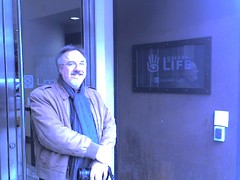 A high point of the afternoon, however, occurred as we were walking back to the hotel. We were approaching a doorway, where two women were waiting to get in. As we got to the point where we could see the door, it buzzed open and the women entered, revealing the sign that identified the company. I was struck first by the logo of a hand, and then the name of the company, Second Life. Being in San Francisco, I initially thought that this was some sort of new age something. Then I saw in slightly smaller text, Linden Lab. Wow! I was standing at the door of Linden Lab, the makers of
A high point of the afternoon, however, occurred as we were walking back to the hotel. We were approaching a doorway, where two women were waiting to get in. As we got to the point where we could see the door, it buzzed open and the women entered, revealing the sign that identified the company. I was struck first by the logo of a hand, and then the name of the company, Second Life. Being in San Francisco, I initially thought that this was some sort of new age something. Then I saw in slightly smaller text, Linden Lab. Wow! I was standing at the door of Linden Lab, the makers of